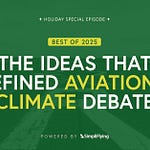Welcome to Season 3 of Sustainability in the Air, the world’s first podcast dedicated to sustainable aviation. Through in-depth conversations with top aviation leaders, we break through the clutter and provide a clear roadmap for a net-zero future.
In this episode of our ‘Sustainability in the Air’ podcast, Boeing’s Vice President of Environmental Sustainability, Sheila Remes speaks with SimpliFlying CEO Shashank Nigam and shares how the airframer is collaborating with industry stakeholders to move aviation towards its 2050 net zero goal.
Before joining Boeing, Remes worked at America West and United Airlines and has served for over 30 years in the industry. At Boeing, Remes oversees environmental sustainability strategy and focuses on continuously improving Boeing’s products, services and operations.
You can listen and subscribe to our podcast on all major podcast platforms or read our deep dive into the episode below.
The Sustainable Flight Demonstrator programme with NASA (3:35)
Can growth and sustainability co-exist? (5:38)
The Cascade data model to get to net zero (8:30)
The ecoDemonstrator programme (11:12)
The possibility of 100% SAF-powered flights (13:45)
The promise and pitfalls of SAF (17:50)
The First Movers Coalition (20:10)
Investment in alternative fuels and technologies (21:40 & 30:55)
Understanding the impact of contrails (26:48)
How Boeing achieved net zero operations (32:08)
How realistic is the industry’s net zero goal? (38:40)
Rapid Fire! (40:06)
For over a decade, Boeing has been busy preparing for the future, whether it is through its ecoDemonstrator flight test program or its dynamic data model called Cascade for estimating a pathway to net zero or through its impressive repertoire of cross-sectoral partnerships. Recently, for example, NASA announced a collaboration with Boeing to build a new fuel-efficient single-aisle commercial aircraft by 2028. Remes talks us through these developments and more in this wide-ranging conversation.
SUGAR, yes, please
In January 2023, NASA and Boeing announced that they will work together on the Sustainable Flight Demonstrator project to build, test and fly an emission-reducing single-aisle aircraft. Boeing will build and test a full-sized airliner based on its transonic truss-braced wing (TTBW) concept, using long, thin, strut-braced wings to add lift, reduce drag, and burn 30% less fuel. The first test flight is expected around 2028.
Remes mentions that Boeing has been exploring various concepts with NASA for over a decade now. The latest announcement is part of what is known as the “Subsonic Ultra Green Aircraft Research” (SUGAR) concept that was set in motion many years ago.
“In 2008, NASA asked the industry and academia to explore and develop these different advanced concepts that can meet the anticipated commercial air transportation needs. So that’s where that design concept has come out of. We’ll continue to work with NASA on what that might turn out to be”, she says.
The partnership, supported by the Funded Space Act Agreement, will rely on technical expertise and facilities and $425 million from NASA over seven years. Meanwhile, Boeing and its partners will contribute the remaining $725 million and the technical plan.
ecoDemonstrator: From the lab to the skies
Apart from their partnership with NASA, Boeing also has its own ecoDemonstrator programme that tests promising technologies in an operational environment. Overall, the programme’s goals are to test technologies that enhance safety, improve efficiency and minimise the environmental footprint.
“The benefit of having a flying testbed”, says Remes, “is that we can take those technologies out of the labs, and really test them in the real world.” Over the 10 years of the programme, around 230 different technologies have been tested, and about a third of them have been validated and made their way back into Boeing’s products and services.
Remes shares some examples of technologies on airplanes today that have gone through the ecoDemonstrator programme. The most recognisable, of course, would be the winglets on the MAX aircraft that enabled a significant improvement on fuel burn.
Remes says they’ve also done a lot of work with the Boeing Global Services teams. For example, in iPad apps that allow pilots to have real-time weather, as well as other information that helps improve fuel efficiency and reduce emissions while they’re flying. Or custom flight path approaches that reduce community noise.
Till now, nine airplanes have served as flying test beds for the programme since it began in 2012. The latest ecoDemonstrator is a Boeing-owned 777-200ER that will test about 30 projects.
The promise of 100% SAF-powered flights
In December 2022, Virgin Atlantic announced that it had secured UK government funding to operate a 100% Sustainable Aviation Fuel (SAF) operated flight from London to New York in 2023. The flight will be operated by one of Virgin Atlantic’s Boeing 787 Dreamliners, powered by Rolls-Royce Trent 1000 engines, which have already successfully flown on 100% SAF during tests.
On being asked about the upcoming flight, Remes is quick to state that the ecoDemonstrator actually flew with 100% SAF back in 2018 with FedEx Express on a 777 freighter. “Since that time, we’ve done a number of collaborations across customers, trying to learn more about 100% SAF, as well as learn more about integrating SAF into an operation and at an airport; working with regulators and the government”, she says.
In fact, Remes says Boeing and Virgin Atlantic were actually the first ones to do a SAF test on their 747s back in 2008. That experience helped shape the pathway for certification and future use. The 2023 flight is expected to be fuelled by SAF made primarily by waste oils and fats, such as cooking oils.
In addition, the overall flight will be net zero. While SAF will account for 70% of the emissions reduction, the remaining 30% reduction will come from carbon removal through biochar credits. (Biochar is a material that traps and stores carbon taken from the atmosphere.)
While Boeing will provide technical support for the flight, the project is spearheaded by a British-led consortium of Rolls-Royce, Boeing, Imperial College London, University of Sheffield, Rocky Mountain Institute (RMI), and ICF.
“You can travel in a car from say New York to San Francisco. It’ll take you five days and 120 gallons of fuel. Or you can travel on a 787 in five hours and 33 gallons per passenger. So there’s a lot of goodness that is enabled with the air transportation movement.”
Reaching net zero through data modelling
Boeing’s work in sustainability extends beyond the material aspect of its planes. At Farnborough 2022, the airframer unveiled a new data modelling tool called Cascade to show the most effective scenarios for reaching net zero by 2050. The model was created in consultation with leading universities.
Remes says that the tool was built on the fundamentals of the Waypoint 2050 report, an industry report showing the scenarios of what was going to be needed to get to net zero by 2050. Boeing’s dynamic Cascade model takes this further by actually “cascading” improvements associated with the various technologies and options that the industry has to improve.
The model quantifies four different levers of improvement: fleet renewal, operational efficiency, renewable energy, as well as new aircraft advanced technology. Remes clarifies that the dynamic nature of the model also allows the stakeholders to define their assumptions of the future, and see the implications of those choices.
“One of the elements really unique for this particular model is around carbon intensity”, says Remes. The model can help understand the lifecycle benefits of any energy source. The key benefit for an airline is that the model can show the timing of impact as well as what needs to be put in place so that the gains of an initiative are not lost.
Net zero operations
In 2020 and 2021, Boeing committed to attaining net zero across manufacturing and worksites, reducing Scope 1 and Scope 2 emissions. Remes explains that this was possible through a back-to-basics three-pronged approach:
Conservation efforts: Since 2018, Boeing employees have been involved in a friendly conservation competition called ‘Battle of the Buildings’. The program aims to reduce and improve equipment and processes in everyday operations, and bring about cultural and mindset transformation. Over 230,000 actions were undertaken last year, some of which include simple efforts like recycling materials, picking up foreign object debris and turning off lights.
Purchasing renewable electricity: By January 2022, nearly 20% of energy use in Boeing factories was powered through renewable electricity procured via solar, wind and hydropower facilities. Additional multi-state agreements are also underway to purchase carbon-neutral power for Boeing sites in Illinois, Indiana, Ohio, and Pennsylvania.
Purchasing offsets: Against the remaining emissions, Boeing purchases offsets that meet rigorous requirements set by Verified Carbon Standard (VCS), American Carbon Registry or Gold Standard. They support projects that offer co-benefits or the added benefits that may result from these carbon mitigation efforts. Boeing adheres to the CORSIA norms for offsets while also introducing further stringency, explains Remes. Examples of some of the projects include Indigenous Reservation of the Mataven Forest, Liangdu Afforestation Project in China and Winston Creek Forest Carbon Project.
Our Take
Decarbonising aviation is a complex issue that requires all industry stakeholders to work together. Since aviation remains, more or less, as good as its tools, aircraft manufacturers bear a huge responsibility in moving the industry towards net zero emissions, especially as we rely on fleet renewal in the short term.
Boeing has made significant headway in sustainable innovations and helping the industry lay out a feasible net zero roadmap. Its ecoDemonstrator, Cascade data modelling tool, net zero operations are laudable efforts in this regard.
As a strategic partner in the electric, vertical takeoff and landing (eVTOL) vehicle company Wisk, Boeing is also exploring the possibilities of autonomous air taxis. That’s not all. Boeing has also partnered with Mitsubishi Heavy Industries to promote SAF, hydrogen, and electrification. Moreover, it has also developed and tested linerless cryogenic fuel tanks with NASA, a technology breakthrough which further supports hydrogen-based fuels in aviation.
As Remes says, air travel connects the world, and has become an integral part of society. Since flying is set to increase in the years to come – and Remes believes it is a net good – actively disengaging from fossil fuels is critical. Apart from SAF, moving to alternate technologies like hydrogen and electric propulsion is essential.
Ultimately, without industry stalwarts like Boeing leading the way, the upcoming transition to green flying will be hard to effect. Smaller companies lack the wherewithal of the likes of Boeing and are unlikely to stay afloat on ideas and interesting innovations alone.
Luckily, Remes feels there’s much reason for optimism. “I have seen the innovation that this industry is able to bring to the table”, she says. “We’ve improved from the start of the jet age and reduced emissions by 70%. So I believe we can do this.”
Our Sustainability in the Air podcast is powered by SimpliFlying which has been helping build trust in travel for over a decade.
This season of the podcast is brought to you by Cirium and CarbonClick. As a sustainability partner, Cirium helps the aviation industry gain a much clearer view of carbon emissions and develop methods to reduce them, enabling on the industry promise to fly sustainably. CarbonClick is the industry leader in managing transparent carbon offsetting programs for individuals and top global airlines.














